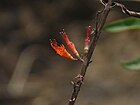Note: This is a project under development. The articles on this wiki are just being initiated and broadly incomplete. You can Help creating new pages.
Difference between revisions of "Woodfordia fruticosa - Dhataki"
(→References) |
(→List of Ayurvedic medicine in which the herb is used) |
||
| (3 intermediate revisions by the same user not shown) | |||
| Line 1: | Line 1: | ||
| − | [[File: | + | [[File:Woodfordia fruticosa flowers at Peravoor (3).jpg|thumb|right|''Dhataki'']] |
'''Woodfordia fruticosa''' is a wonderful medicinal herb commonly known as Dhataki. It is powerful astringment. It relaxes pitta and kapha doshas. | '''Woodfordia fruticosa''' is a wonderful medicinal herb commonly known as Dhataki. It is powerful astringment. It relaxes pitta and kapha doshas. | ||
| Line 46: | Line 46: | ||
==List of Ayurvedic medicine in which the herb is used== | ==List of Ayurvedic medicine in which the herb is used== | ||
| − | + | [[Mustharishtam]], [[Sarivadyasava]], [[Chandanadi tailam]], [[Kutajashtaka kashayam]], [[Lohaasava]] | |
| − | |||
| − | |||
| − | |||
<ref name="Ayurvedic preparations"/> | <ref name="Ayurvedic preparations"/> | ||
| Line 55: | Line 52: | ||
==Mode of Propagation== | ==Mode of Propagation== | ||
| − | {{Propagation|Seeds}}, {{Propagation|Softwood cutting}}. | + | {{Propagation|Seeds}}, {{Propagation|Softwood cutting}}, {{Propagation|Hardwood cuttings}}. |
==How to plant/cultivate== | ==How to plant/cultivate== | ||
| Line 65: | Line 62: | ||
==Photo Gallery== | ==Photo Gallery== | ||
<gallery class="left" caption="" widths="140px" heights="140px"> | <gallery class="left" caption="" widths="140px" heights="140px"> | ||
| − | + | Dhataki (Telugu- ధాతక) (3491778970).jpg | |
| − | + | ||
| − | + | ||
| − | + | Dhavadi (Gujarati- ધાવડી) (452036656).jpg | |
| − | + | ||
| + | |||
| + | Dhawai (Hindi- धवइ) (2396497906).jpg | ||
| + | |||
| + | |||
| + | Dhayati (Marathi- धायटी) (2395659911).jpg | ||
| + | |||
| + | Woodfordia fruiticosa.jpg | ||
| + | |||
| + | Woodfordia fruticosa - Fire Flame Bush flowers at Peravoor 2018 (4).jpg | ||
| + | |||
</gallery> | </gallery> | ||
Latest revision as of 13:08, 2 April 2022
Woodfordia fruticosa is a wonderful medicinal herb commonly known as Dhataki. It is powerful astringment. It relaxes pitta and kapha doshas.
Contents
- 1 Uses
- 2 Parts Used
- 3 Chemical Composition
- 4 Common names
- 5 Properties
- 6 Habit
- 7 Identification
- 8 List of Ayurvedic medicine in which the herb is used
- 9 Where to get the saplings
- 10 Mode of Propagation
- 11 How to plant/cultivate
- 12 Commonly seen growing in areas
- 13 Photo Gallery
- 14 References
- 15 External Links
Uses
Piles, Dysentery, Menorrhagia.
Parts Used
Chemical Composition
It contains the chemical compounds like tannins (especially those of macrocyclic hydrolysable class), flavonoids, anthraquinone glycosides, and polyphenols.[1]
Common names
| Language | Common name |
|---|---|
| Kannada | Are hoo, Bela |
| Hindi | Ban-mahendi, Dauri |
| Malayalam | Tamrapushpi, Tatire |
| Tamil | Cirincippu, Dhathari-jargi |
| Telugu | Are puvvu, Dhaarhupushpika |
| Marathi | Daayatti, Datyatti |
| Gujarathi | |
| Punjabi | |
| Kashmiri | |
| Sanskrit | Agnijvala, Dhataki. |
| English |
.[2]
Properties
Reference: Dravya - Substance, Rasa - Taste, Guna - Qualities, Veerya - Potency, Vipaka - Post-digesion effect, Karma - Pharmacological activity, Prabhava - Therepeutics.
Dravya
Rasa
Kashaya (Astringent)
Guna
Laghu (Light), Rooksha (Dry)
Veerya
Sheeta (Cold)
Vipaka
Katu (Pungent)
Karma
Kapha, Pitta
Prabhava
Habit
Identification
Leaf
| Kind | Shape | Feature |
|---|---|---|
| Simple | Opposite | Leaves subsessile, 4-11 x 2-4 cm, ovate-lanceolate or lanceolate, subcoriaceous, whitish velvety tomentose and finely orangish- or black-punctate beneath. |
Flower
| Type | Size | Color and composition | Stamen | More information |
|---|---|---|---|---|
| Bisexual | Axillary cymes | Crimson | 12 | Slightly zygomorphic, in 2-16-flowered axillary cymes; pedicels to 1 cm long. |
Fruit
| Type | Size | Mass | Appearance | Seeds | More information |
|---|---|---|---|---|---|
| Capsule | 0.6-1 x 0.25-0.4 cm | Ellipsoid, included in the calyx | Seeds numerous, trigonous-ovoid |
Other features
List of Ayurvedic medicine in which the herb is used
Mustharishtam, Sarivadyasava, Chandanadi tailam, Kutajashtaka kashayam, Lohaasava [4]
Where to get the saplings
Mode of Propagation
Seeds, Softwood cutting, Hardwood cuttings.
How to plant/cultivate
Plants are frost tolerant. Requires a sunny position.[5]
Commonly seen growing in areas
Sunny places, Agricultural land, Open waste land, Degraded places.
Photo Gallery
References
External Links
- Ayurvedic Herbs known to be helpful to treat Piles
- Ayurvedic Herbs known to be helpful to treat Dysentery
- Ayurvedic Herbs known to be helpful to treat Menorrhagia
- Herbs with Stem used in medicine
- Herbs with Leaves used in medicine
- Herbs with Roots used in medicine
- Herbs with common name in Kannada
- Herbs with common name in Hindi
- Herbs with common name in Malayalam
- Herbs with common name in Tamil
- Herbs with common name in Telugu
- Herbs with common name in Marathi
- Herbs with common name in Sanskrit
- Habit - Shrub
- Index of Plants which can be propagated by Seeds
- Index of Plants which can be propagated by Softwood cutting
- Index of Plants which can be propagated by Hardwood cuttings
- Herbs that are commonly seen in the region of Sunny places
- Herbs that are commonly seen in the region of Agricultural land
- Herbs that are commonly seen in the region of Open waste land
- Herbs that are commonly seen in the region of Degraded places
- Herbs
- Lythraceae






